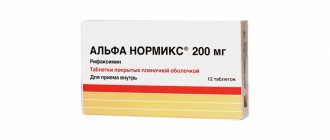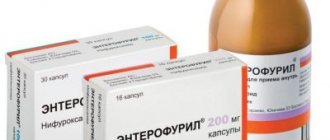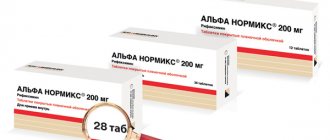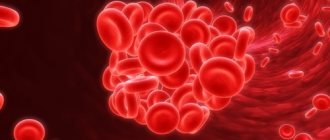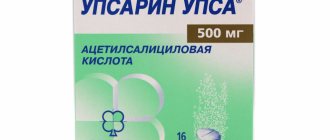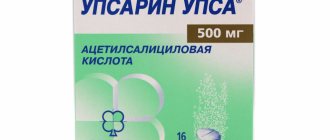Pharmacological properties of the drug Alpha Normix
Pharmacodynamics. Rifaximin is a broad-spectrum antibiotic and is a semi-synthetic derivative of rifamycin SV. Irreversibly binds the β-subunits of the bacterial enzyme, DNA-dependent RNA polymerase and, therefore, inhibits the synthesis of RNA and bacterial proteins. As a result of irreversible binding to the enzyme, rifaximin exhibits bactericidal properties against sensitive bacteria. The drug has a wide spectrum of antibacterial activity, including most gram-negative and gram-positive, aerobic and anaerobic bacteria that cause gastrointestinal infections, including traveler's diarrhea. Gram-negative Aerobes: Salmonella spp., Shigella spp., Escherichia coli, including enteropathogenic strains, Proteus spp., Campylobacter spp., Pseudomonas spp., Yersinia spp., Enterobacter spp., Klebsiella spp., Helicobacter pylori ; anaerobes: Bacteroides spp., including Bacteroides fragilis, Fusobacterium nucleatum ; Gram-positive aerobes: Streptococcus spp., Enterococcus spp. , including Enterococcus fecalis, Staphylococcus spp. ; anaerobes: Clostridium spp. , including Clostridium difficile and Clostridium perfrigens, Peptostreptococcus spp. . Absorption of rifaximin in the α polymorphic form in the gastrointestinal tract when taken orally is insignificant (≤1%). The antibiotic acts locally in the intestine, where its high concentration is achieved, significantly higher than the minimum inhibitory concentration for the tested enteropathogenic microbes (after 3 days of therapy, a fecal level of 4000–8000 mcg/g is achieved when taking a daily dose of 800 mg). Due to this, rifaximin has a pronounced antibacterial effect. The use of the drug helps to reduce pathogenic intestinal bacterial flora, which causes some pathological conditions or is involved in their pathogenesis. The drug reduces:
- the formation by bacteria of ammonia and other toxic compounds, which in the case of severe liver disease, accompanied by a violation of the detoxification process, are involved in the pathogenesis of hepatic encephalopathy;
- increased proliferation of bacteria in intestinal microbial overgrowth syndrome;
- the presence of bacteria in the intestinal diverticulum, which may be involved in inflammation in and around the diverticulum and may play a key role in the development of symptoms and complications of diverticulosis;
- antigenic stimuli that, in the presence of genetically determined defects in mucosal immunoregulation and/or protective function, can induce or permanently maintain chronic intestinal inflammation;
- risk of infectious complications during colorectal surgery.
Due to the virtually absent absorption of rifaximin in the gastrointestinal tract, there is no risk of systemic side effects. In numerous clinical studies, rifaximin was always well tolerated by patients. Pharmacokinetics Rifaximin oral absorption is ≤1% based on pharmacokinetic studies in rats, dogs and humans. The drug is not detected in blood plasma after administration in therapeutic doses (detection limit ≤0.5–2 ng/ml) or is detected in very low concentrations (less than 10 ng/ml in almost all cases) both in healthy volunteers and in patients with damaged intestinal mucosa (as a result of ulcerative colitis or Crohn's disease). Rifaximin found in urine is no more than 0.5% of the dose taken orally. Almost all rifaximin taken orally is found in the gastrointestinal tract, where very high concentrations of the drug are achieved (concentrations in feces of 4000-8000 mcg/g are achieved after 3 days of taking the drug at a daily dose of 800 mg). Comparative pharmacokinetic studies have demonstrated that polymorphic forms of rifaximin are absorbed from the intestine in greater quantities than polymorphic form α.
Alpha normix®
Rifaximin is a broad-spectrum antibiotic from the rifamycin group. Like other representatives of this group, it irreversibly binds the beta subunit of the bacterial enzyme DNA-dependent PEK polymerase and, therefore, inhibits the synthesis of RNA and bacterial proteins.
As a result of irreversible binding to the enzyme, rifaximin exhibits bactericidal properties against sensitive bacteria. The drug has a wide spectrum of antimicrobial activity, including most gram-negative and gram-positive, aerobic and anaerobic bacteria.
The broad antibacterial spectrum of rifaximin helps reduce the pathogenic intestinal bacterial load, which causes some pathological conditions.
The drug reduces:
- the formation by bacteria of ammonia and other toxic compounds, which in the case of severe liver disease, accompanied by a violation of the detoxification process, play a role in the pathogenesis and clinical manifestations of hepatic encephalopathy;
- increased proliferation of bacteria in the syndrome of excessive growth of microorganisms in the intestines;
- the presence of bacteria in the colon diverticulum, which can cause inflammation in and around the diverticular sac and may play a key role in the development of symptoms and complications of diverticular disease;
- an antigenic stimulus that, in the presence of genetically determined defects in mucosal immunoregulation and/or protective function, can initiate or constantly maintain chronic intestinal inflammation;
— the risk of infectious complications during colorectal surgery.
Mechanism of resistance
The development of resistance to rifaximin is caused by reversible damage to the rB gene, which encodes bacterial RNA polymerase. The occurrence of resistant subpopulations among bacteria isolated from patients with traveler's diarrhea was low. According to clinical studies, a three-day course of rifaximin therapy in patients with traveler's diarrhea was not accompanied by the emergence of resistant gram-positive (enterococci) and gram-negative (Escherichia coli) bacteria. With repeated use of rifaximin in high doses in healthy volunteers and in patients with inflammatory bowel diseases, rifaximin-resistant strains appeared, however, they did not colonize the gastrointestinal tract (GIT) and did not displace rifaximin-sensitive strains.
When therapy was stopped, resistant strains quickly disappeared. Experimental and clinical data suggest that the use of rifaximin in patients with traveler's diarrhea and latent infection with Mycobacterium tuberculosis and Neisseria meningitidis will not be associated with the selection of rifampicin-resistant strains.
Sensitivity
In vitro susceptibility testing cannot be used to determine the sensitivity or resistance of bacteria to rifaximin. At present, clinical data are insufficient to establish cutoff values for evaluating susceptibility tests. Rifaximin was evaluated in vitro against traveler's diarrhea pathogens from four regions of the world: enterotoxigenic and enteroaggregative strains of E. coli, Salmonella spp., Shigella spp., non-cholera vibrios, Plesiomonas spp., Aeromonas spp. and Campylobacter spp. The MIC90 (minimum inhibitory concentration) for the isolated strains was 32 μg/ml, a level easily achievable in the intestinal lumen as a result of the high concentration of rifaximin in the feces. Because rifaximin alpha polymorph has low absorption from the gastrointestinal tract and acts locally in the intestinal lumen, it may not be clinically effective against invasive bacteria, even if these bacteria are sensitive to it in vitro.
Use of the drug Alpha Normix
Suspension Adults and children over 12 years of age: 10 ml oral suspension 3 times daily to 20 ml oral suspension 2–3 times daily (600–1200 mg rifaximin). Children aged 6 to 12 years: 10 ml oral suspension 2–3 times daily to 20 ml oral suspension 2 times daily (400–800 mg rifaximin). Children aged 2 to 6 years: 5 ml oral suspension 2-3 times daily to 10 ml oral suspension 3 times daily (200-600 mg rifaximin). For the treatment of adults and children over 6 years of age, instead of an oral suspension, Alpha Normix can be used in the form of film-coated tablets, 200 mg each. Tablets Adults and children over 12 years of age: from 1 tablet 3 times a day to 2 tablets 2-3 times a day (600-1200 mg rifaximin). Children aged 6 to 12 years: from 1 tablet 2-3 times a day to 2 tablets 2 times a day (400-800 mg of rifaximin). The duration of treatment should not exceed 7 days and depends on the clinical effect in patients. If necessary, repeated courses of treatment can be carried out with a break of 20–40 days. The total duration of therapy depends on the adequacy of the clinical effect in patients. Doses and frequency of administration can be changed on the recommendation of a doctor. Preparation of the suspension The granules for the preparation of the oral suspension are in a hermetically sealed bottle. The bottle must be opened, water added to the mark and shaken well. Add water again until the slurry reaches the specified level. The concentration of rifaximin in the finished suspension is 100 mg per 5 ml. To measure 5, 10 or 15 ml of suspension, add a measuring cup. The suspension remains stable for 7 days at room temperature. Before taking the drug, the bottle must be shaken well.
Alpha Normix
Alpha Normix
(lat.
alfa normix
) - intestinal non-systemic broad-spectrum antibiotic. The active substance is rifaximin.
Release forms of Alpha Normix
Alpha Normix is available in the form of:
- granules for the preparation of suspension for oral administration
- pink film-coated tablets
Alpha Normix granules for oral suspension contain 100 mg of rifaximin in every 5 ml of granules. One tablet of Alpha Normix contains 200 mg of rifaximin.
Alpha Normix - antibacterial agent
Alpha Normix is active against the following microorganisms:
- gram-negative bacteria
- aerobic and microaerophilic Helicobacter pylori, Campylobacter spp., Salmonella spp., Shigella spp.
, enteropathogenic strains
of Escherichia coli, Proteus spp., Pseudomonas spp., Yersinia spp., Enterobacter spp., Klebsiella spp. - anaerobic: Bacteroides spp.
, including
Bacteroides fragilis, Fusobacterium nucleatum
- aerobic: Streptococcus spp., Enterococcus spp
., including
Enterococcus faecalis, Staphylococcus spp. - anaerobic: Clostridium spp.
, including
Clostridium difficile
and
Clostridium perfrigens
,
Peptostreptococcus spp
.
Indications for use of Alpha Normix
Alpha Normix is used to treat infectious diseases of the gastrointestinal tract caused by microorganisms sensitive to it, including:
- travelers diarrhea
- acute gastrointestinal infections
- bacterial overgrowth syndrome
- hepatic encephalopathy
- uncomplicated diverticulosis of the colon
- Crohn's disease
- ulcerative colitis
Alpha Normix is also indicated for the prevention of infectious complications during colorectal surgery.
Professional medical articles regarding the use of Alpha Normix in the eradication of Helicobacter pylori
- Karimov M.M., Saatov Z.Z., Spiridonova A.Yu., Akhmatkhodzhaev A.M. The use of alpha normix in a complex of eradication therapy in patients with duodenal ulcer.
On the website gastroscan.ru in the literature catalog there is a section “Antibiotics used in the treatment of gastrointestinal diseases”, containing articles on the use of antimicrobial agents in the treatment of diseases of the digestive tract.
Alpha Normix in the eradication scheme of Helicobacter pylori and the treatment of acid-related diseases
Standards for the diagnosis and treatment of acid-dependent and Helicobacter pylori-associated diseases recommend Alpha Normix in one of the “second-line” regimens (used if the patient had an unsuccessful attempt to eradicate Helicobacter pylori
using one of the “first-line” regimens):
- one of the standard dosage proton pump inhibitors (omeprazole 20 mg, lansoprazole 30 mg, pantoprazole 40 mg, esomeprazole 20 mg or rabeprazole 20 mg twice a day), amoxicillin (500 mg 4 times a day or 1000 mg twice a day) , alpha normix (400 mg rifaximin 2 times a day), bismuth tripotassium dicitrate (120 mg 4 times a day) for 14 days.
Alpha Normix is not used in the eradication of Helicobacter pylori
outside of special regimens, without drugs that reduce gastric acidity.
Alpha Normix is also not used in any form for the treatment of gastric and duodenal ulcers and gastritis in the absence of Helicobacter pylori in the patient.
Method of use of Alpha Normix and dosage
Tablets
: Unless the doctor has prescribed a different order of administration, patients over 12 years of age take orally from one Alpha Normix tablet every 8 hours to two Alpha Normix tablets every 8–12 hours, which corresponds to 600-1200 mg of rifaximin.
The duration of therapy should not exceed 7 days and is determined by the condition of the patients. A second course of treatment should be carried out no earlier than after 20–40 days. Suspension
. To prepare the suspension, open a bottle of Alpha Normix granules, add water to the mark and shake well. Water is then added repeatedly until the suspension level reaches the specified 60 ml mark. The concentration of rifaximin in the prepared suspension is 100 mg per 5 ml. To measure 5, 10 or 15 ml of suspension, use the measuring cup included with the drug. The prepared suspension is stable for a week at room temperature not exceeding 30 °C. Shake the bottle with the suspension well before taking it.
Use of Alpha Normix during pregnancy and lactation
Pregnant women can take Alpha Normix only when absolutely necessary and under the direct supervision of a doctor. During treatment with Alpha Normix, breastfeeding should be discontinued.
general information
According to the pharmacological index, Alpha Normix belongs to the “Ansamycin” group, according to ATC, to the “A07A” group. Intestinal antimicrobial and anti-inflammatory drugs" and has the code "A07AA11 rifaximin".
- Instructions for medical use of the drug Alpha Normix. Film-coated tablets. Granules for the preparation of suspension for oral administration (pdf).
The manufacturer of Alfa Normix is Alfa Wassermann, SpA, Italy.
Trade names of drugs containing the active ingredient rifaximin
Only Alpha Normix is registered in Russia.
In the United States, rifaximin is sold under the brand name Xifaxan. On the European market - under the trade names Spiraxin, Zaxine, Normix, Rifacol and Colidur. Alpha Normix has contraindications, side effects and application features; before taking it, consultation with a specialist is necessary.
Back to section
Side effects of the drug Alpha Normix
Analysis of safety data showed that the risk of side effects when using Alpha Normix is very low. These effects are limited primarily to gastrointestinal disturbances (nausea, dyspepsia, vomiting, abdominal pain and cramps), are mild to moderate and usually self-limit without the need for dose changes or interruption of therapy. The drug is practically not absorbed from the gastrointestinal tract, which eliminates the risk of developing systemic side effects. In rare cases, skin reactions such as urticaria may occur, which are likely due to individual intolerance to treatment. The risk of side effects is 0.7–2% of all cases of drug use. Post-marketing surveillance data confirm the above risk assessment and the nature of the observed events.
Special instructions for the use of Alpha Normix
During prolonged treatment with high doses or when the intestinal mucosa is damaged, a small amount of the drug (≤1%) may be absorbed, which can cause urine to turn reddish. This is due to the active substance, which, like most antibiotics of this series (rifamycins), has a red-orange color. Use during pregnancy and lactation. Rifaximin did not cause teratogenic effects in rats and rabbits. Adequate data and well-controlled studies in pregnant women are lacking. Since reproductive toxicity studies in animals do not allow assessment of the possibility of a toxic effect in humans, during pregnancy the drug should be taken only in cases of urgent need and under the direct supervision of a physician. The penetration of rifaximin into breast milk has not been studied, but is expected to be negligible due to very low absorption into the systemic circulation. Therefore, the use of Alpha Normix by women who are breastfeeding is permitted with appropriate medical supervision. The ability to influence the reaction rate when driving vehicles or other mechanisms. Not installed.
